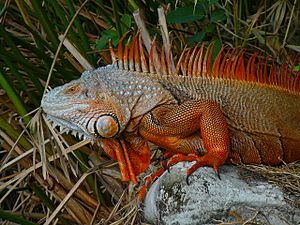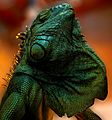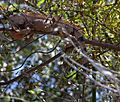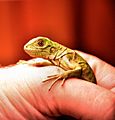American iguana facts for kids
Quick facts for kids Green iguana |
|
|---|---|
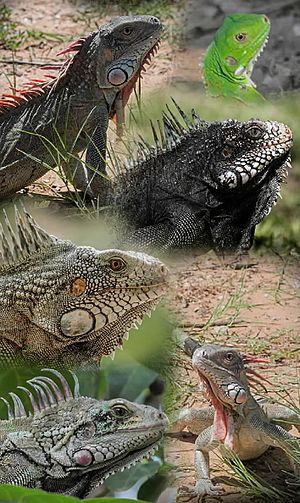 |
|
| Green iguana at Baradidas Zoo, Venezuela | |
| Scientific classification | |
| Kingdom: | |
| Class: | |
| Order: | |
| Family: |
Iguanidae
|
| Genus: | |
| Binomial name | |
| Iguana iguana |
|
The green iguana or common iguana (Iguana iguana) is a large lizard. It lives in trees and eats plants. These amazing reptiles are found in Central America, South America, and the Caribbean islands. They belong to a group of lizards called Iguana.
Contents
Where Green Iguanas Live
Green iguanas live in a very large area. You can find them from southern Brazil and Paraguay all the way north to Mexico. They are also common on Caribbean islands, like Puerto Rico. In the United States, they live in South Florida (including the Florida Keys), Hawaii, and the Rio Grande Valley of Texas.
How Green Iguanas Behave
When a green iguana feels scared, it tries to run away. If there's water nearby, it will dive in and swim to safety. If it can't escape, it has ways to defend itself.
An iguana might puff up its body and hiss. It can also extend the loose skin under its neck, called a dewlap. It will bob its head to show it's ready to fight. If the danger continues, the iguana can whip its tail, bite, or use its sharp claws. Injured iguanas are more likely to fight back.
Green iguanas also use head bobs and their dewlaps to talk to each other. They use these movements to greet other iguanas or to find a mate. The way they bob their heads has special meanings that other iguanas understand.
Birds that hunt, like hawks, are predators of green iguanas. If an iguana hears a hawk's sound, it will often freeze. This makes it easier for people to catch them in the wild.
What Green Iguanas Eat
Green iguanas are mainly herbivores, which means they eat only plants. In the wild, they eat leaves, flowers, fruits, and new shoots from over 100 different types of plants. For example, in Panama, they love to eat wild plums.
It's important for iguanas to get the right balance of minerals from their food. They need a specific amount of calcium compared to phosphorus. For pet iguanas, a good diet includes leafy greens like turnip greens and collards. They also enjoy fruits and vegetables such as butternut squash, mango, and parsnip.
Young iguanas sometimes eat the droppings of adult iguanas. This helps them get special tiny living things (called microflora) in their stomachs. These microflora help them digest their plant-only diet, which can be hard to break down.
There's some discussion about whether pet green iguanas should eat meat. In the wild, iguanas have sometimes been seen eating grasshoppers or tree snails by accident while eating plants. Some wild adult iguanas have even been seen eating birds' eggs.
However, many experts believe that eating meat is not healthy for iguanas in the long run. It can cause serious health problems, like kidney failure. This can make them die sooner. So, it's best for pet iguanas to stick to a diet of only plants. They can get all the vitamins and minerals they need from a good plant-based diet.
Images for kids
-
Green iguana in Maracaibo
-
In Palo Verde National Park, Costa Rica
-
Juvenile green iguana, Grand Cayman
-
Young juvenile green iguana, found indoors in Curaçao
-
At the Botanical Garden at Portoviejo, Ecuador
-
At Saint Thomas, U.S. Virgin Islands (possibly Iguana iguana melanoderma instead)
See also
 In Spanish: Iguana verde para niños
In Spanish: Iguana verde para niños


